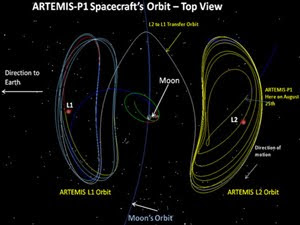
In August 1960, NASA launched its first communications satellite, Echo 1. Fifty years later, NASA has achieved another first by placing the ARTEMIS-P1 spacecraft into a unique orbit behind the moon, but not actually orbiting the moon itself. This type of orbit, called an Earth-Moon libration orbit, relies on a precise balancing of the Sun, Earth, and Moon gravity so that a spacecraft can orbit about a virtual location rather than about a planet or moon. The diagrams below show the full ARTEMIS-P1 orbit as it flies in proximity to the moon. ARTEMIS-P1 is the first spacecraft to navigate to and perform stationkeeping operations around the Earth-Moon L1 and L2 Lagrangian points. There are five Lagrangian points associated with the Earth-Moon system.
The two points nearest the moon are of great interest for lunar exploration. These points are called L1 (located between the Earth and Moon) and L2 (located on the far side of the Moon from Earth), each about 61,300 km (38,100 miles) above the lunar surface. It takes about 14 to 15 days to complete one revolution about either the L1 or L2 point. These distinctive kidney-shaped orbits are dynamically unstable and require weekly monitoring from ground personnel. Orbit corrections to maintain stability are regularly performed using onboard thrusters. After the ARTEMIS-P1 spacecraft has completed its first four revolutions in the L2 orbit, the ARTEMIS-P2 spacecraft will enter the L1 orbit. The two sister spacecraft will take magnetospheric observations from opposite sides of the moon for three months, then ARTEMIS-P1 will move to the L1 side where they will both remain in orbit for an additional three months.
Flying the two spacecraft on opposite sides, then the same side, of the moon provides for collection of new science data in the Sun-Earth-Moon environment. ARTEMIS will use simultaneous measurements of particles and electric and magnetic fields from two locations to provide the first three-dimensional perspective of how energetic particle acceleration occurs near the Moon's orbit, in the distant magnetosphere, and in the solar wind. ARTEMIS will also collect unprecedented observations of the space environment behind the dark side of the Moon – the greatest known vacuum in the solar system – by the solar wind. In late March 2011, both spacecraft will be maneuvered into elliptical lunar orbits where they will continue to observe magnetospheric dynamics, solar wind and the space environment over the course of several years.
The two points nearest the moon are of great interest for lunar exploration. These points are called L1 (located between the Earth and Moon) and L2 (located on the far side of the Moon from Earth), each about 61,300 km (38,100 miles) above the lunar surface. It takes about 14 to 15 days to complete one revolution about either the L1 or L2 point. These distinctive kidney-shaped orbits are dynamically unstable and require weekly monitoring from ground personnel. Orbit corrections to maintain stability are regularly performed using onboard thrusters. After the ARTEMIS-P1 spacecraft has completed its first four revolutions in the L2 orbit, the ARTEMIS-P2 spacecraft will enter the L1 orbit. The two sister spacecraft will take magnetospheric observations from opposite sides of the moon for three months, then ARTEMIS-P1 will move to the L1 side where they will both remain in orbit for an additional three months.
Flying the two spacecraft on opposite sides, then the same side, of the moon provides for collection of new science data in the Sun-Earth-Moon environment. ARTEMIS will use simultaneous measurements of particles and electric and magnetic fields from two locations to provide the first three-dimensional perspective of how energetic particle acceleration occurs near the Moon's orbit, in the distant magnetosphere, and in the solar wind. ARTEMIS will also collect unprecedented observations of the space environment behind the dark side of the Moon – the greatest known vacuum in the solar system – by the solar wind. In late March 2011, both spacecraft will be maneuvered into elliptical lunar orbits where they will continue to observe magnetospheric dynamics, solar wind and the space environment over the course of several years.
No comments:
Post a Comment